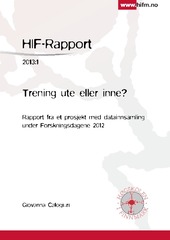Blar i tittel Artikler, rapporter og annet (Idrettshøgskolen)
Viser treff 76-80 av 80
-
TRAINING EFFCT DURING THE MIDNIGHTSUN PERIOD IN DIFFERENT CHRONOTYPES
(Conference object; Konferansebidrag, 2017)Our research takes place at 70oN. Where the sun is above the horizon for 8 weeks during summer, midnight sun and below the horizon for 8 weeks during winter, polar night. Earlier we found that adults with different chronotypes responded differently to exercise performed in day-light or darkness1. During the polar night evening (E) and neither (N) -types respond to training better than morning (M) ... -
The Training of Olympic Alpine Ski Racers
(Journal article; Tidsskriftartikkel; Peer reviewed, 2018-12-21)Alpine combined was the only alpine ski racing event at the first Winter Olympic Games in 1936, but since then, slalom, giant slalom, super-G, downhill, and team events have also become Olympic events. Substantial improvements in slope preparation, design of courses, equipment, and the skills of Olympic alpine skiers have all helped this sport attain its present significance. Improved snow ... -
Trening ute eller inne? Rapport fra et prosjekt med datainnsamling under Forskningsdagene 2012.
(Research report; Forskningsrapport, 2013-07-10) -
Web-based exercise versus supervised exercise for decreasing visceral adipose tissue in older adults with central obesity: A randomized controlled trial
(Journal article; Tidsskriftartikkel; Peer reviewed, 2020-05-12)<i>Background</i> - Visceral adipose tissue (VAT) is a strong risk factor for cardiovascular disease and increases with age. While supervised exercise (SE) may be an effective approach, web-based exercise (WE) have other advantages such as being more readily accessible. Therefore, we evaluated the effects of WE on VAT, body composition and cardiometabolic risk markers in centrally obese older adults ... -
Whole-body vibrations associated with alpine skiing: A risk factor for low back pain?
(Journal article; Tidsskriftartikkel; Peer reviewed, 2018-03-09)Alpine skiing, both recreational and competitive, is associated with high rates of injury. Numerous studies have shown that occupational exposure to whole-body vibrations is strongly related to lower back pain and some suggest that, in particular, vibrations of lower frequencies could lead to overuse injuries of the back in connection with alpine ski racing. However, it is not yet known which ...


 English
English norsk
norsk



